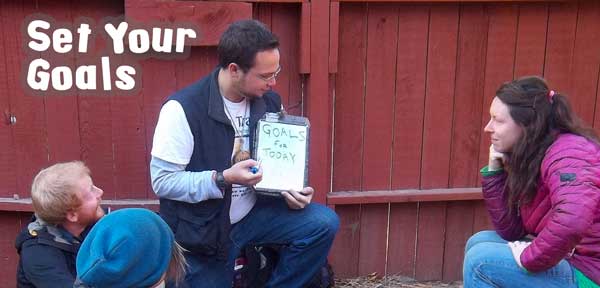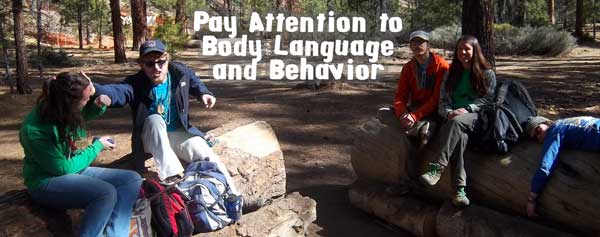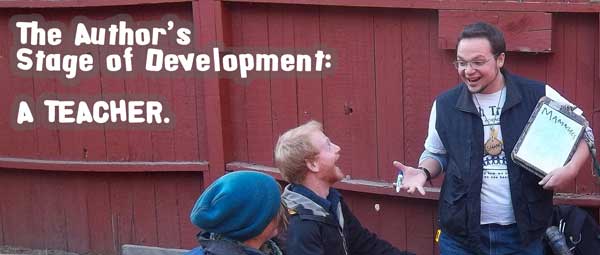Team Discovery Hike: it’s the first activity you do with your field group on their first day at High Trails. It’s time for the group to discover who you are, where they are, and what they are doing this week. It’s also a time for you, the instructor, to discover your field group and beyond setting the tone you want, it’s time for you to pay attention to your group and what little adjustments you will make to maximize their experience.
While the Team Discovery Hike is valuable to set expectations and the tone for the week, take a moment during each hike and activity to go through this GRABBSS Assessment. This tool is used to assess your group of students, evaluating them in situations during the week to make their learning experience unique and overall effective.

G is for Goals
Quality goals are clear and concise enough that your students should be able to remember and recite them.
Instructors should think of goals both in the short term and long term. For example: does your group know the goals of their stay at High Trails? Do they know they are supposed to be safe, learn, and try new things? Do they know the goals of the class (not just for Team Discovery Hike, but for all their classes?) Have you stated and reiterated their goals? Knowing clear purposes for being at High Trails will give them clear understanding, motivation, and accountability for the week.

R is for Readiness
Have you done all you can do get your group ready to work towards their goals? Do they have the equipment they need? Have you prepared their mindset for lessons and activities? Students want to be ready for what’s next; getting their attention and telling them the order of events will help you manage your outdoor classroom.
For example, telling students that first they will have a discussion for ten minutes, next they will do an activity about their discussion, then there will be a wrap up, and finally a snack break. Allowing students to ready themselves mentally by telling them the order of events will improve their accountability to themselves.
A is for Affect
Are you presenting yourself in a way that will facilitate the group’s success? Remember that 97% of communication is your body language presentation. Smiles and enthusiasm can get students bought into challenging classes and situations.
I had a group of students who were incredibly polite and adventurous; their affect changed when the weather went cold, wet, and snowy. This, in turn, unconsciously changed my body language, and so in the midst of a transition from one place to another, I took a conscious effort to say to myself, “I’m seeing frowns, shivers, and shutting eyes – I need to change my presentation.” I altered my lectures and discussions to the game show format – involving more personality and movement from me and my students. It kept them active in the cold, standing and smiling, which is a much more desired affect from the teacher and students.

B is for Behavior
Especially in those first minutes of meeting your group of students, when you have crossed from secondhand knowledge to firsthand experience: what behaviors are you observing? Which students are pairing off? Which student is volunteering to be first to help? When students are misbehaving, why are you seeing those behaviors?
Remember, to work with children you must believe in their potential. Set solid expectations for their observable behaviors, help them establish and understand their goals, and continue to observe and analyze their behaviors as their experience develops. You may see behaviors change over the week – so set clear expectations from the beginning about the quality of their observable behaviors with each other in the group.
B is for Body
This category deals with the physical structure of your students and the body language they communicate. Are you working with fifth or sixth graders? Any physical limitations, special needs or concerns? How does the group carry itself through the physical landscape and what will you respond with?
Recently I led a group of sixth graders from a K – 6 grade school. They presented themselves as very eager and attentive to each other in the physical landscape of the wilderness. This allowed me to carry out bigger and more exciting routes, as we traveled and explored for hands-on learning. On the other hand, I’ve also had 6th graders from a 6 – 12 grade school, and social dynamics can change tremendously as that age group is no longer the oldest in the school but now the youngest. For that, I had to take into account students in transitional friendships, social situations, and varied levels of maturity. I had to structure activities and partners to avoid conflict and ensure success.
Preadolescence is a dynamic life stage that affects the physical, mental, emotional, and social aspects of children. Keep this in mind as you continue to assess your group.

S is for Setting
Assess the physical surroundings around you and your group, and use them to your group’s advantage. What can be used to help you – sunshine for warmth, trees for shade, open areas for activities or breaks. Are your students going to need to take a break to take some scenic pictures? Are your surroundings too bare and cold to keep them focused?
For example, I recently worked a week where the weather was sunny and sixty degrees all day; my students were eager for movement, exploration, and learning. The next day, it snowed all day and the beautiful setting had changed completely. The energy and focus of these students had also changed and it was my task to tailor the programming to meet their new needs. No longer looking for a sunny spot to do activities, we hiked to find clusters of trees to shelter us from the falling snow, eat snacks, and conserve our energy during classes.
Settings affect your group, so be certain manuever the setting to the group’s advantage.

S is for Stage of Development
Students change as they grow comfortable in their new environment in the outdoor classroom. The nervousness or excitement they may feel fades away as they get to know you and their new surroundings. The group on the Team Discovery Hike the first day will not be the same group on their last class as they communicate and progress through experiences together.
As they begin to understand the boundaries, so will they begin to push them. Use this comfort and understanding to expand roles within the group; create leaders, establish group cultural routines (group cheers, contracts, etc.)
I often use the Team Discovery Hike to tell students to take a break from who they are at school and try being the person they want to be during the adventures of the week: the hero, the adventurer or the brave student. This allows me, towards the end of the week, to remind them that this group of people at this time and place will never exist again, and to make the most of their time together. Using this language from the first activity to the end of their experience lays the safe groundwork for their group development of time.

You don’t need to use this tool every single week, but understanding GRABBSS will help set you up for success in the beginning with your group, as well as get your group moving when you notice they might be spinning their wheels at a given moment during the week. By no means does this need to be a formal tool to be completed every day, but going through the checklist will set you in the direction you plan to go and it will help you maintain your course, especially when the unexpected happens (as it always does).
At High Trails Outdoor Science School, we literally force our instructors to write about elementary outdoor education, teaching outside, learning outside, our dirty classroom (the forest…gosh), environmental science, outdoor science, and all other tree hugging student and kid loving things that keep us engaged, passionate, driven, loving our job, digging our life, and spreading the word to anyone whose attention we can hold for long enough to actually make it through reading this entire sentence. Whew…. www.dirtyclassroom.com


Comments are closed.